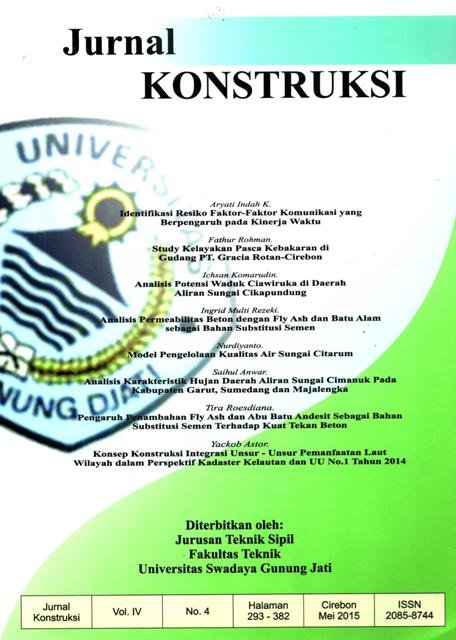Analisis Permeabilitas Beton Dengan Fly Ash dan Abu Batu Alam Sebagai Bahan Substitusi Semen
DOI:
https://doi.org/10.33603/jki.v4i4.2256Abstract
ABSTRAK
Penccmaran udara merupakan masalah yang banyak dialami kota-kota di Indonesia. Udara yang tercemar dapat diakibatkan oleh adanya industri dilingkungan sekitar. Industri pemotongan batu alam dan PLTU di Cirebon menghasilkan fly ash dan abu batu banyak mengandung polutan yang bcrbahaya bagi kesehatan dan lingkungan. Oleh karena itu. perlu dilaksanakan sejauh mana dampak dan pemanfaatan limbah abu batu alam maupun fly ash terhadap lingkungan.
Fly ash PLTU Kanci dan abu batu alam Bobos digunakan sebagai substitusi semen pada pembuatan beton. Persentasc pcnambahan substitusi fly ash maupun abu batu adalah 0%. 10%, 20%. dan 30 %. Sampel beton dibuat berbcntuk kubus dengan ukuran 15x15x15 cm. Pcngujian permeabilitas dilakukan saat umur beton 28 hari dengan menggunakan alat permeabilitas sederhana.
Nilai persentase rongga udara, persentase lolos air dan kecepatan air pada fly ash sebagai substitusi semen lebih kecil daripada abu batu. Nilai kecepatan air yang diakibatkan fly ash dibawah 0,000022 cnTdet, sedangkan kecepatan air minimum pada abu batu sebesar 0,053 cm/det. Ini menandakan beton yang disubstitusi fly ash akan lebih awet dan tahan lama.
Kata Kunci: Fly Ash, Abu Batu, Permeabilitas Beton,
Â
ABSTRACT
Air pollution is a problem experienced in many cities in Indonesia. Polluted air can be caused by the industrial environment around. Natural stone cutting industry and power plant in Cirebon produce fly ash and stone ash that contains of many pollutants that are harmful for health and the environment. Therefore, research should be carried out the impact and utilization natural stone ash and fly ash on the environment.
PLTU Kanci Fly ash and Bobos natural stone used as a substitute for cement in concrete manufacture. The percentage of fly ash and stone ash used to substitution cement is 0%, 10%. 20%, and 30%. Concrete samples made cuboid with the size of 15x15x15 cm'. Permeability’ testing concrete at the age of 28 days with a simple permeability system.
The value percentage of air voids, the percentage of water and water velocity in fly ash as a cement substitute smaller than the stone ash. Water velocity value resulting fly ash under 0.000022 cm / sec, while the minimum water velocity in the stone ash of0.053 cm/sec. This indicates that substitutedflv ash concrete will be more durable.
Keywords: Fly Ash. Stone ash, Concrete Permeability.
Â
References
Daftar Pustaka
Aji Julatif, Mohamad. 2015, Pcngaruh Pcnambahan Limbah Batubara terhadap Kapasitas Kuat Tekan dan Permeabilitas Beton, Fakultas Teknik Sipil Universitas Swadaya Gunung Jati Cirebon.
Alvah, Syahreza. 2005. Pengaruh Penambahan zat Aditif Terhadap Permeabilitas Beton dan Kuat Tekan Beton.
Anonim. 2002, Annual Book o/ASTM Standarts 2002. Volume 04.03, USA : ASTM Intcrnasional.
Dimuljo, Kardiyono. 2007, Teknologi Beton, Yogyakarta: Biro Penerbit Keluarga
Mahasiswa Teknik Sipil, Universitas Gajah Mada
Mulyono, Tri. Teknologi Beton. Penerbit Audi, 2004.
Munir, Misbachul. 2008, Pemanfaatan Abu Batubara (Fly Ash) Untuk Hollow Bloek Yang Bermutu Dan Arnan bagi Lingkungan, Program Magister Ilmu Lingkungan Program Pascasarjana Universitas Diponegoro Semarang.
Neville, A.M. dan Brooks, JJ.I987, Concrete Technology’, New York: Longman
Scientific & Technical.
Sctria, Andri. 2015, Penambahan Limbah Batu Alam Terhadap Pengaruh Kapasitas Kuat Tekan dan Permeabilitas, Fakultas Teknik Sipil Universitas Swadaya Gunung Jati Cirebon.
Downloads
Published
Issue
Section
Citation Check
License
- Authors retain copyright and grant the journal right of first publication with the work simultaneously licensed under a Creative Commons Attribution-ShareAlike 4.0 International License that allows others to share and adapt the work with an acknowledgement of the works authorship and initial publication in this journal.
- Authors are able to enter into separate, additional contractual arrangements for the non-exclusive distribution of the journals published version of the work (e.g., post it to an institutional repository or publish it in a book), with an acknowledgement of its initial publication in this journal.
- Upon receiving the proofs, the Author/Editor agrees to promptly check the proofs carefully, correct any errors, and authorize the publication of the corrected proofs.











